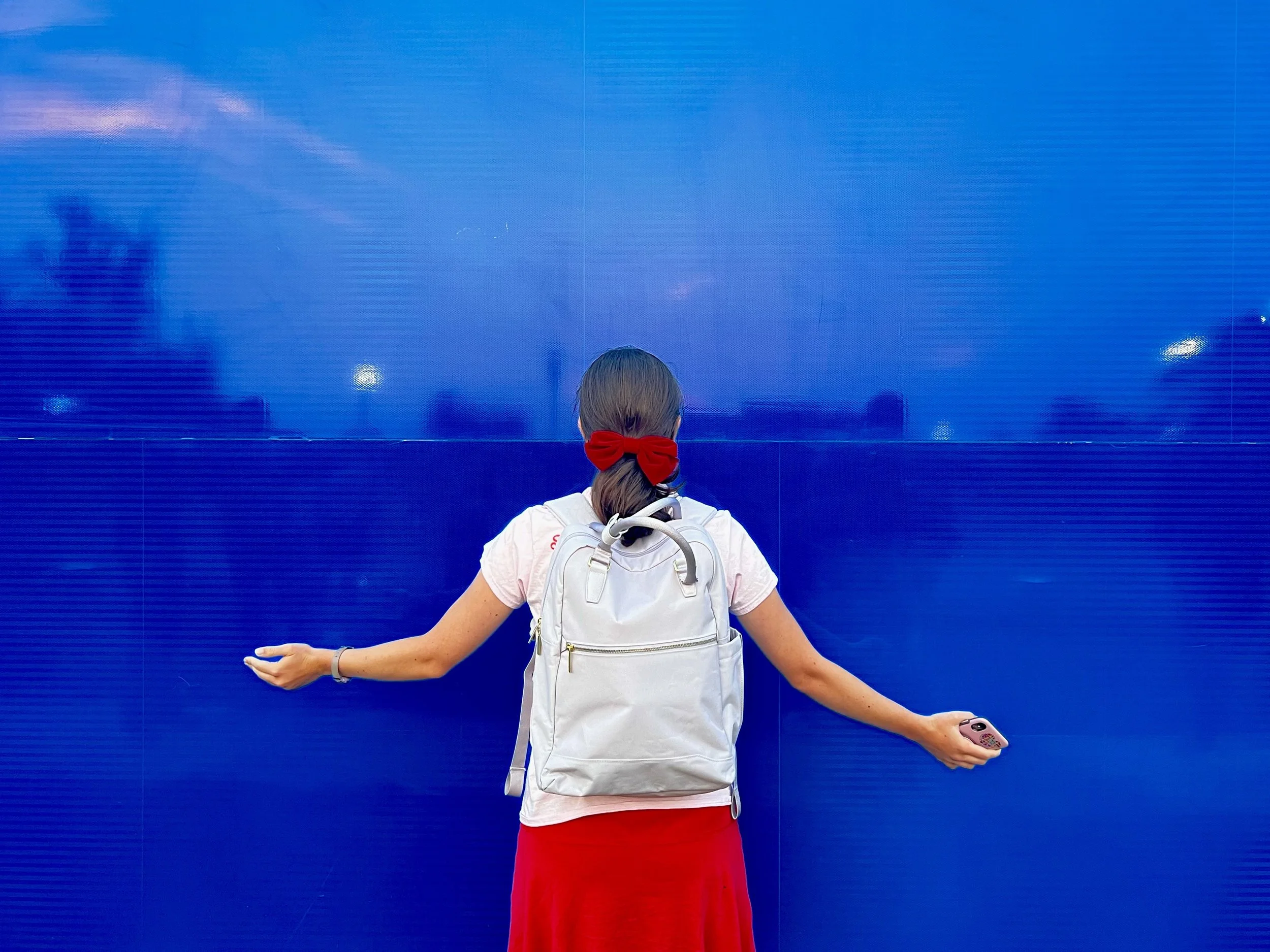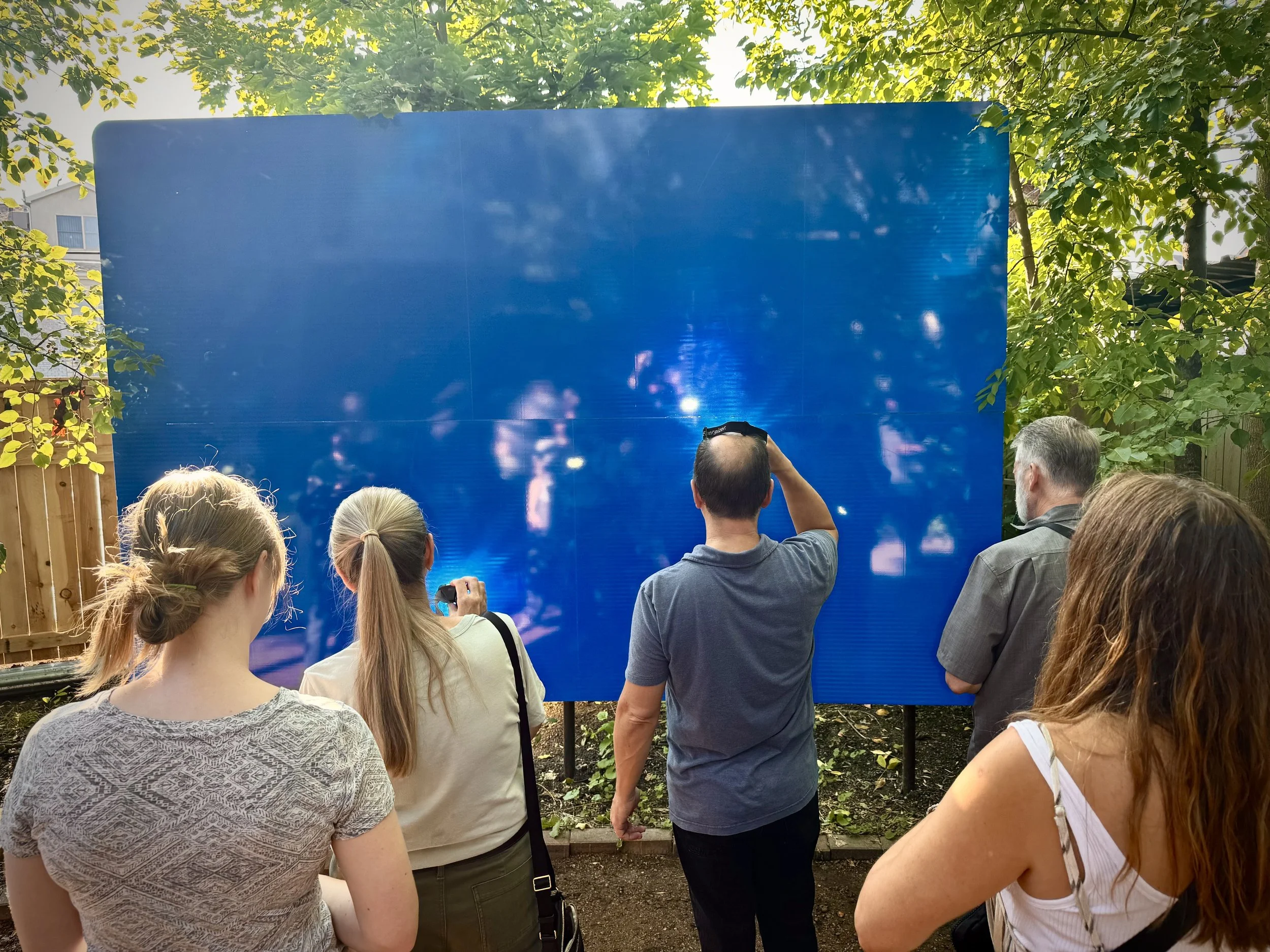Sculpture Garden | Erik L. Peterson: Oasis: Apparition in Blue | September - October 18, 2025
Viewer with The Oasis, 2016-present, High-intensity prismatic film on aluminum, 8 x 12 feet, Photo: Laura Husar Garcia
The Riverside Arts Center is pleased to present Oasis: Apparition in Blue, an interactive installation in our sculpture garden by Erik Peterson, curated by Laura Husar Garcia. Please join us for a reception for the artist on Sunday, September 14th from 3 - 6pm and an Artist Walk and Talk on Saturday, October 11th at 6pm. The exhibition will be on view Thursdays, Fridays, and Saturdays 1-5pm through October 18, 2025.
Opening Reception: Sunday, September 14, 2025, 3:00 - 6:00 PM
Please join us afterwards for a private cocktail hour at the Quincy Street Distillery
Exhibition Dates: September 14 - October 18, 2025
Exhibition on view: Thursdays, Fridays, and Saturdays 1:00 – 5:00 PM
Sunset Oasis: An Artist Walk and Talk with Erik L. Peterson and Laura Husar Garcia:
Saturday, October 11, 2025 at 6:00 PM
Wear comfy shoes, bring your sunglasses, and a headlamp or flashlight, if you have one, we’re going on an art and perception adventure! Connecting sculptural principles with the Sun and our spiraling planet, this artist talk will take us to new places (literally). We’ll begin at the Riverside Arts Center’s Sculpture Garden, then walk (or roll) to the DesPlaines river bend and green suspension bridge for sunset, and head back to RAC for a dark-sky viewing of Oasis and light refreshments.
Oasis invites viewers into an active encounter with perception, public space, and the open-ended meaning of familiar civic forms. At first glance, it appears to be a monumental blue road sign—familiar, directive, municipal. But step closer, and the light transforms the object’s purpose. Light refracts and halos emerge. The sign shimmers like a mirage, destabilizing its own authority and reshaping the viewer’s relationship to the everyday in a playful way.
Through scale, interactivity, and visual distortion Erik L. Peterson reframes a utilitarian artifact into an object of wonder, reflection, and civic interruption. Oasis engages the language of infrastructure and turns it inside out, offering a temporary rupture in the logic of the urban landscape. It is both sculpture and social mirror—a poetic disruption that asks us to slow down, look again, and consider the subtle contradictions embedded in our built environments.
In the lineage of artists who reconfigure the ordinary to illuminate the uncanny, this work reveals the latent theatricality of civic life. Here, signage becomes stagecraft, and the public becomes performer. Oasis resists easy interpretation. It points nowhere—and everywhere—reminding us that meaning, like light, often arrives obliquely.
– Laura Husar Garcia, curator
Oasis, 2016-present, High-intensity prismatic film on aluminum, 8 x 12 feet, Photo: Laura Husar Garcia
Artist’s Description of Oasis
Drawing on the scale and visual vocabularies of highway signage, the ethos of Op-Art, industrial materials of Minimalism, exuberant excesses of American car culture, and the science of retro-reflection, Oasis is a pseudo-painting, a Minimalist sculpture, a cool pool, a sign that is a signifier. Curated by photographer and RAC Exhibitions Committee member, Laura Husar Garcia, Oasis is also a photograph, or at least it converses with the elements of photography - the use of light, the importance of the singular moment, and the insistence of vision itself. I am so excited to bring Oasis to the Riverside Arts Center’s intimate back garden, a deep blue super-flat fountain. Oasis is a large reflective “painting” on aluminum, a large-scale wordless highway sign. This real-life mirage glistening serenely from within the garden transports the viewer, through an otherworldly visual experience, into a cool blue paradise. The work, revealing itself over time, is based on the typology of highway signage and clad in high intensity prismatic sheeting, which reflects light directly to the viewer’s eyes regardless of their position through a process called “retro-reflectivity.”
.
An oasis in the middle of the desert could be lifesaving or a mirage. Is that blue pool of cool water in the distance real or imagined? My work, Oasis plays with the fundamental question of art - can something that is imagined also be real? Inspired by a real highway sign posted on the exit for the Belvidere Oasis rest stop, which reads OASIS in big block letters on a blue field. I wondered, doesn’t the blue color alone signify “oasis”? Why did it need text? Manufactured by Western Remac, a company that produces signs for IDOT, Oasis has many of the trappings of a sign - it is a large aluminum rectangle and utilizes highway spec retro-reflective technology. But without its wayfinding ability, it ceases to be a sign. I see it as a kind of painting, referencing 1970s Op-Art artists who used automotive enamels and industrial processes to make work or the large-scale Color Field paintings of Ellsworth Kelly and Helen Frankenthaler. It is a minimalist sculpture that plays with reflective finishes like Anish Kapoor’s Cloud Gate (“The Bean”) and it is also a type of Earthwork, utilizing the material of the our new “natural” landscapes of highways, cloverleaf exchanges, grassy medians, on-ramps and off-ramps. The scale of highway signs, when brought down to our level and off the highway, feel gigantic. Decoupled from its wayfinding function, the retro-reflective blue prismatic sheeting (designed for hyper-visibility) can now be viewed in its own right - as a purely visual and perceptual experience. It has an eyes-playing-tricks-on-you quality, and is often first noticed with your peripheral vision. What other painting would ask that you look at it with side-eye? The piece has a glassy, flat surface, but it also has a strange kind of visual depth. Oasis is both hyper-visible and yet somehow invisible. Camouflaged in our urban environment, it’s easy to not see.
I love that this piece is coming to Riverside, a place where transportation histories intersect - the river, the railroad, and the highway, and where Frederick Law Olmstead’s masterplan of meandering roads create a sense of wonder and slowness. I hope that you will interact with the work, come close and let your eyes take over. Put on a headlamp and try taking a photo in front of the piece (flash on!) to get a special kind of silhouette portrait. Feel free to share them on social media with the hashtag: #oasisriverside. I would like to sincerely thank Bert Green, Janine Mileaf, Adam Mikos, Natasha Ritsma, Zachary Bishop, Trey Ambrose, C.J. Lind, Ray Klemchuk, Dave Kinishi and the team at Western Remac, Joanne Aono, Laura Husar Garcia, Kent Peterson, Ann Herrold-Peterson, Quyên Lê and Astrid Lê-Peterson. This work would not have been possible without them.
- Erik L. Peterson
Oasis, 2016-2025, High-intensity prismatic film on aluminum, 8 x 12 feet, Photo: Laura Husar Garcia
Artist Statement
With sly wit, a generous spirit, and a wry wink, Erik Peterson’s artworks connect deeply to the ethos of a place and its public, engaging audiences in a playful game of perception and participation, stretching meaning and twisting it like taffy. Peterson’s works cross boundaries and play in the margins, activating different spaces and deploying customized strategies with every piece. Toying with traditions and conventions of art history, exploring our interface with nature, and uncovering the oddities of everyday life, Peterson’s work encourages participation and offers the subtle joy of being in on a secret.
With inspiration stretching from Wal-Mart parking lots to pigeons poking around, fish sanctuaries to Currency Exchanges, the history of softball to traditions of rural baseball, the tragedy of a dropped ice cream cone to the productive possibility in an emerald ash borer trail, gold teeth to wads of chewing gum.
For Peterson, making art is an act of love and mischief.
His artistic process transforms everyday things into strange and magical ciphers. Because the work is inspired by ordinary occurrences, both art lovers and “accidental audiences” are given the keys that can unlock each artwork. Peterson’s work shines a wayward spotlight on the minutiae of everyday life in a way that helps people see the world around them with a bit more clarity, a shot of unexpected levity.
Erik L. Peterson is a public artist, nature playground designer-builder, and educator living and working in Chicago. He is best known for his large-scale urban interventions and neon installations (The Oasis, Inner State, and Seep), reclaimed wood public benches and nature playgrounds (Ashland, Two Sanctuaries, and the Nature Park at We Grow Chicago), signature edible ice cream sculptures (CreamCycle and Soft Palate), and public performances camouflaged within urban spaces (Checks & Balances, Two Tow’n, and Square Dance). His work subtly redefines viewers’ relationships to their own vision and the spaces they inhabit, making the mundane magical and utilizing scale and surprise to re-work how we interact with each other and with the physical things in our world. His large-scale sculptures and performances encourage people to become active participants in the creation of their own public and civic spaces and suffuse public spaces with wry wit and radical hospitality. Additionally, Peterson is a founder of Hyde Park Kunstverein, a community museum that operated out of SHoP in 2010-12 and Qeej Hero, a cross-cultural video game starring a Hmong wind instrument called the qeej.
Peterson has a BFA from Washington University in St. Louis and an MFA from the University of Illinois Chicago. Peterson was lucky enough to spend time at ACRE during its first summer in operation. Subsequently, he was a Bolt Resident in 2012 and later an Artist Mentor alongside Hương Ngô for the Field/Work program at the Chicago Artists’ Coalition. Peterson now serves on CAC’s Board of Directors. Recent shows include Waterways at the Schingoethe Center at Aurora University and an installation of his new piece Two Sanctuaries on the Wild Mile, a floating eco park on the Chicago River. Peterson is currently working on two large-scale public art commissions–Pop Art (Bubble) and Golden Truth–for an arts corridor on Lawrence Avenue in Uptown. Peterson is spending the summer working with two groups of teens, one building out a community garden in Bronzeville and the other creating a large-scale ascending cedar spiral for the backyard of 6018 NORTH.
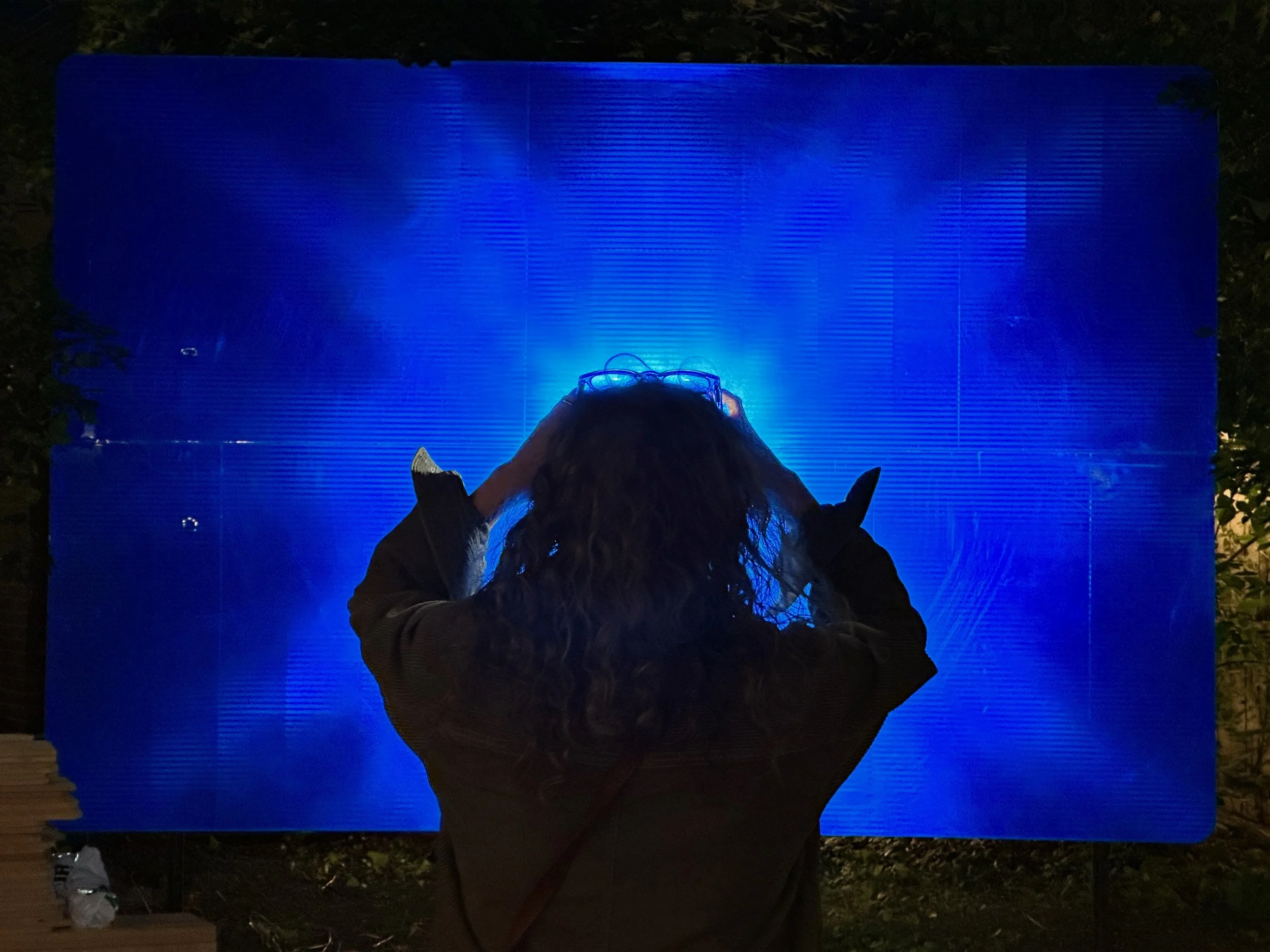
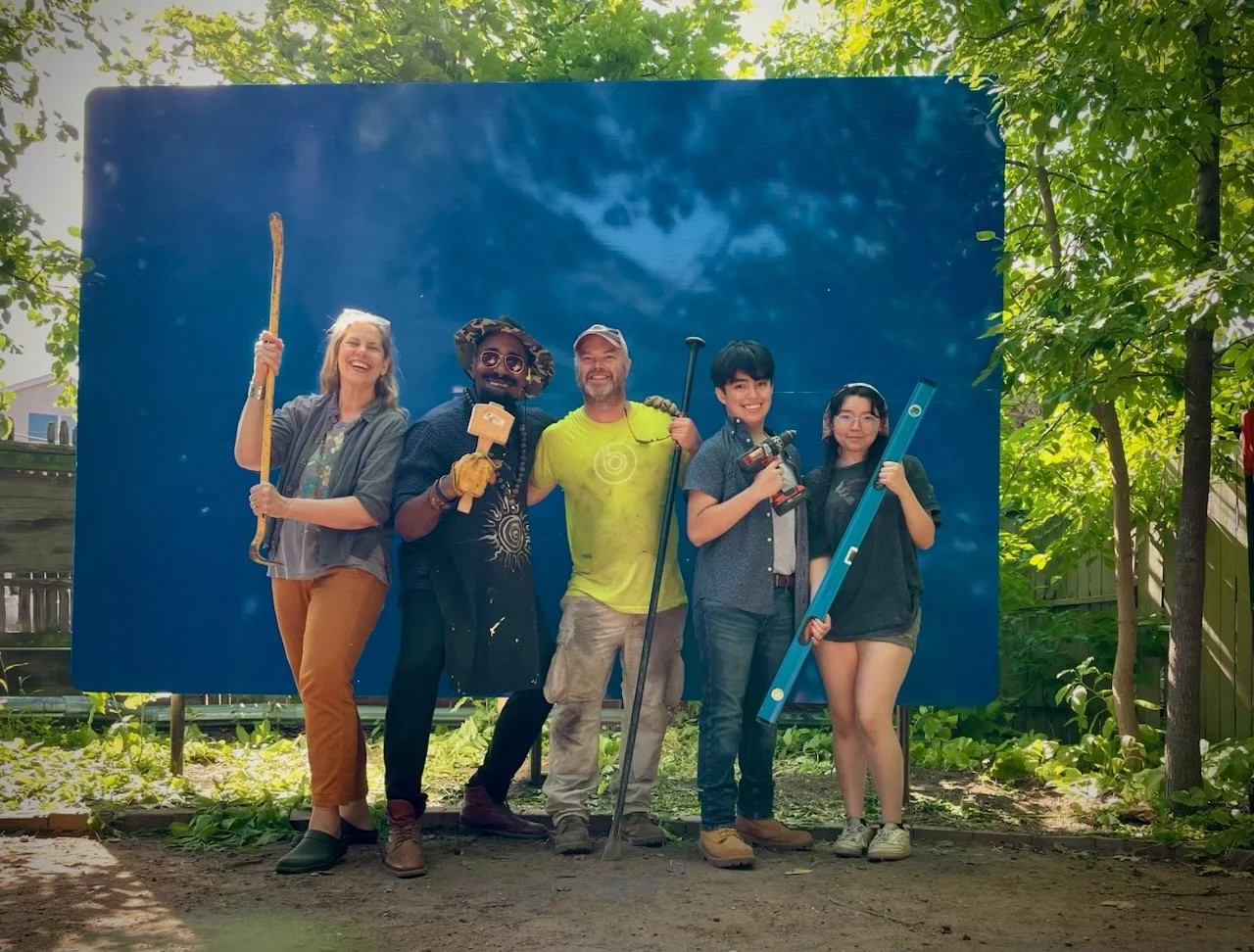



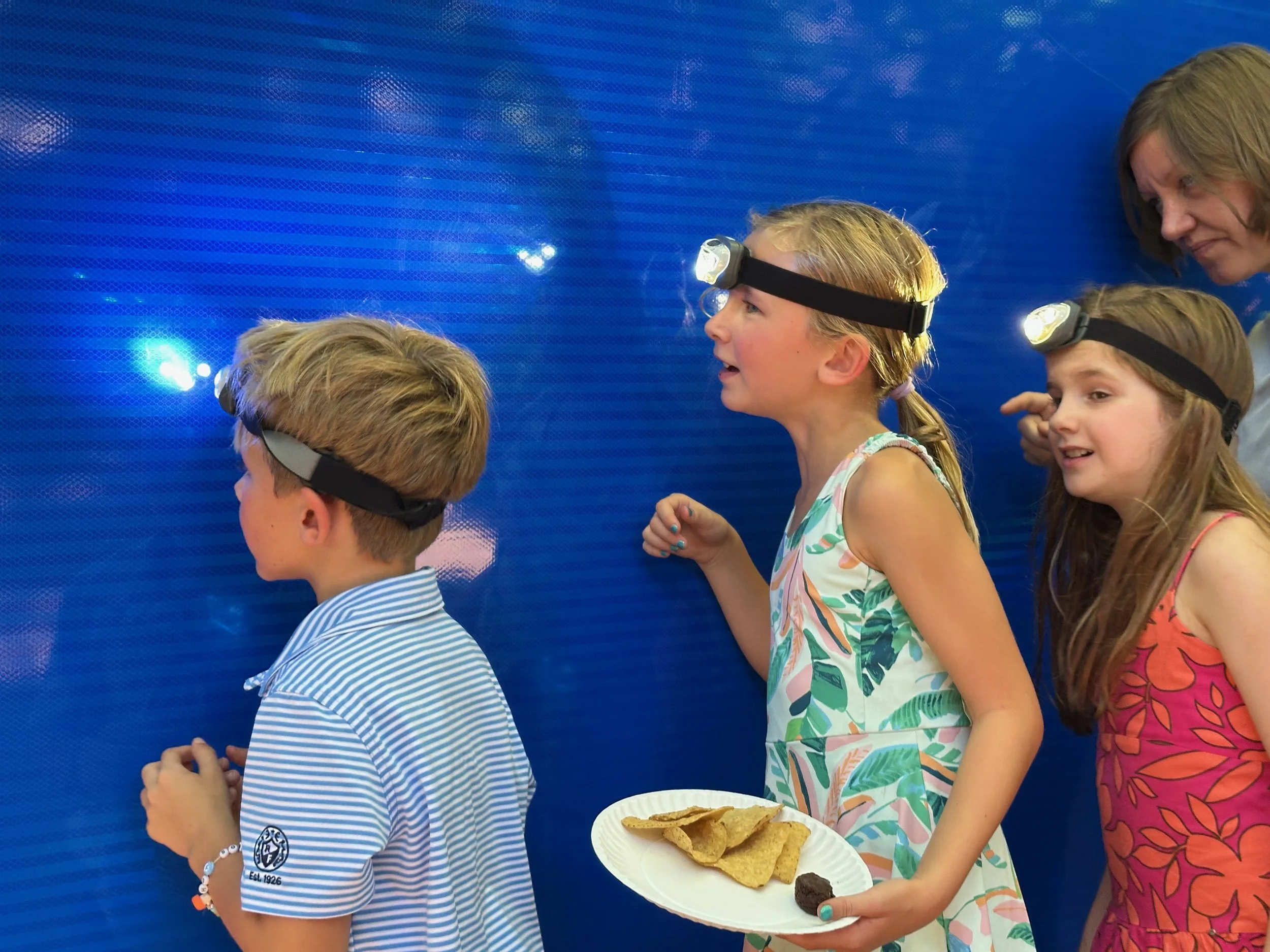
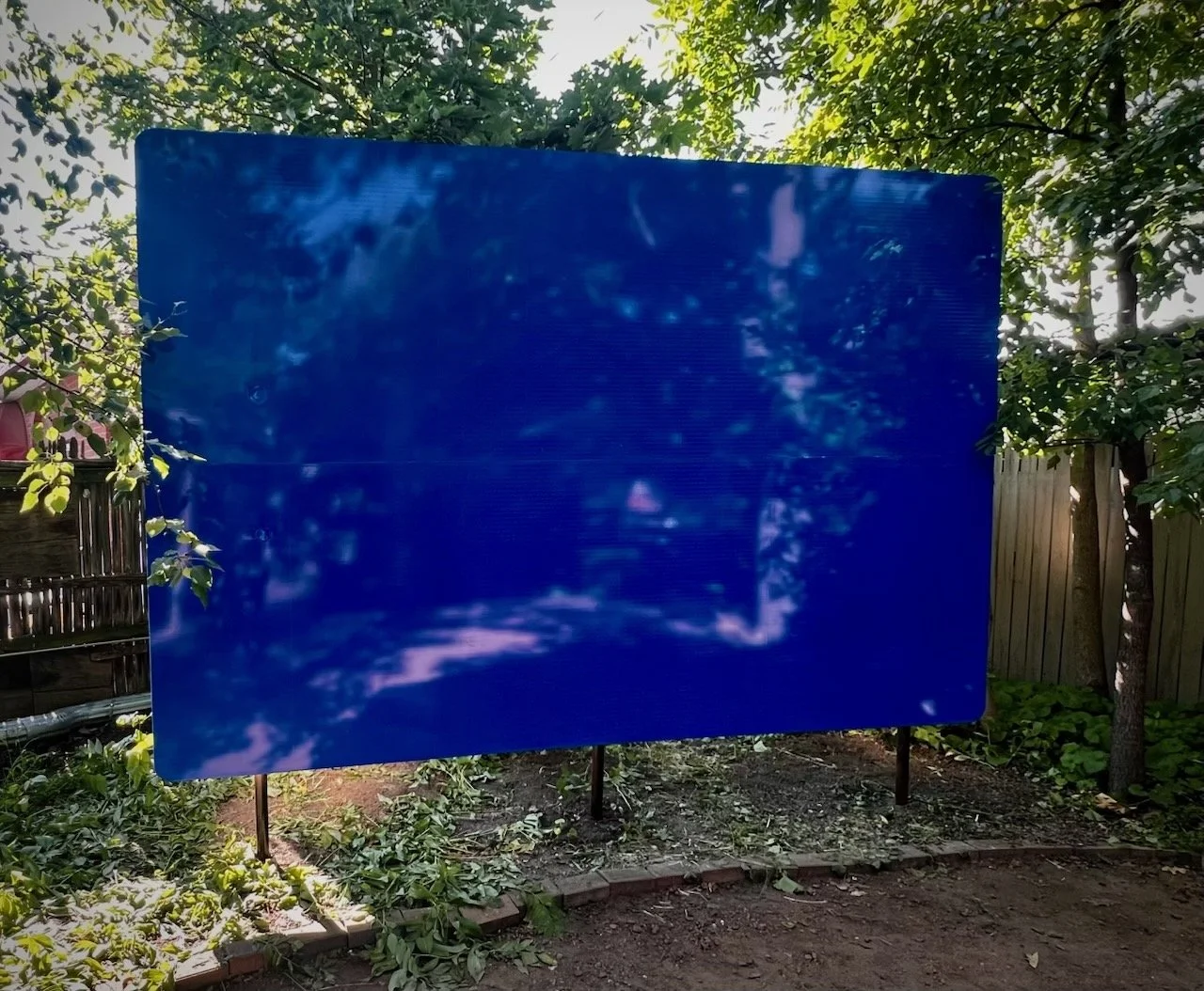




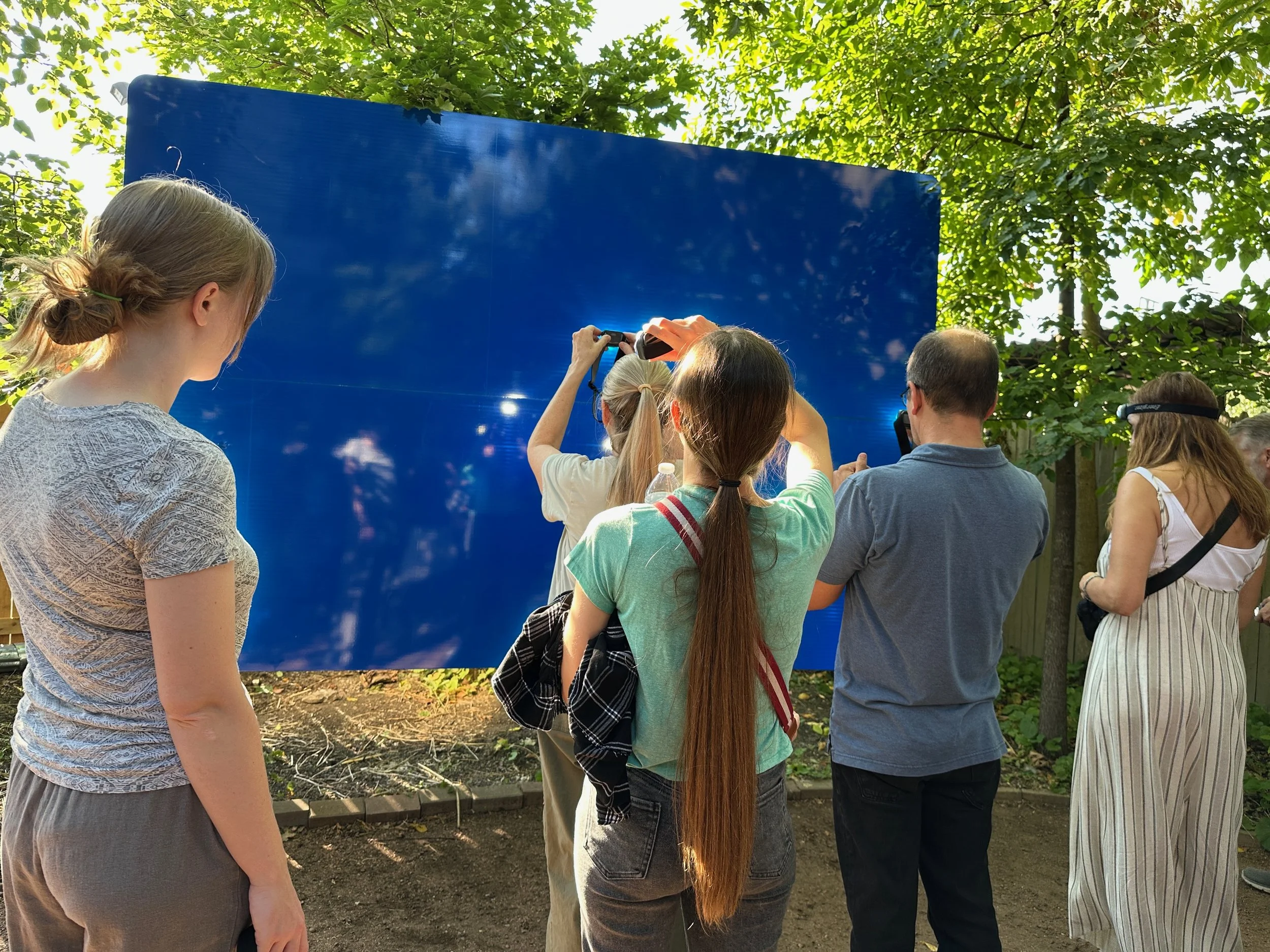
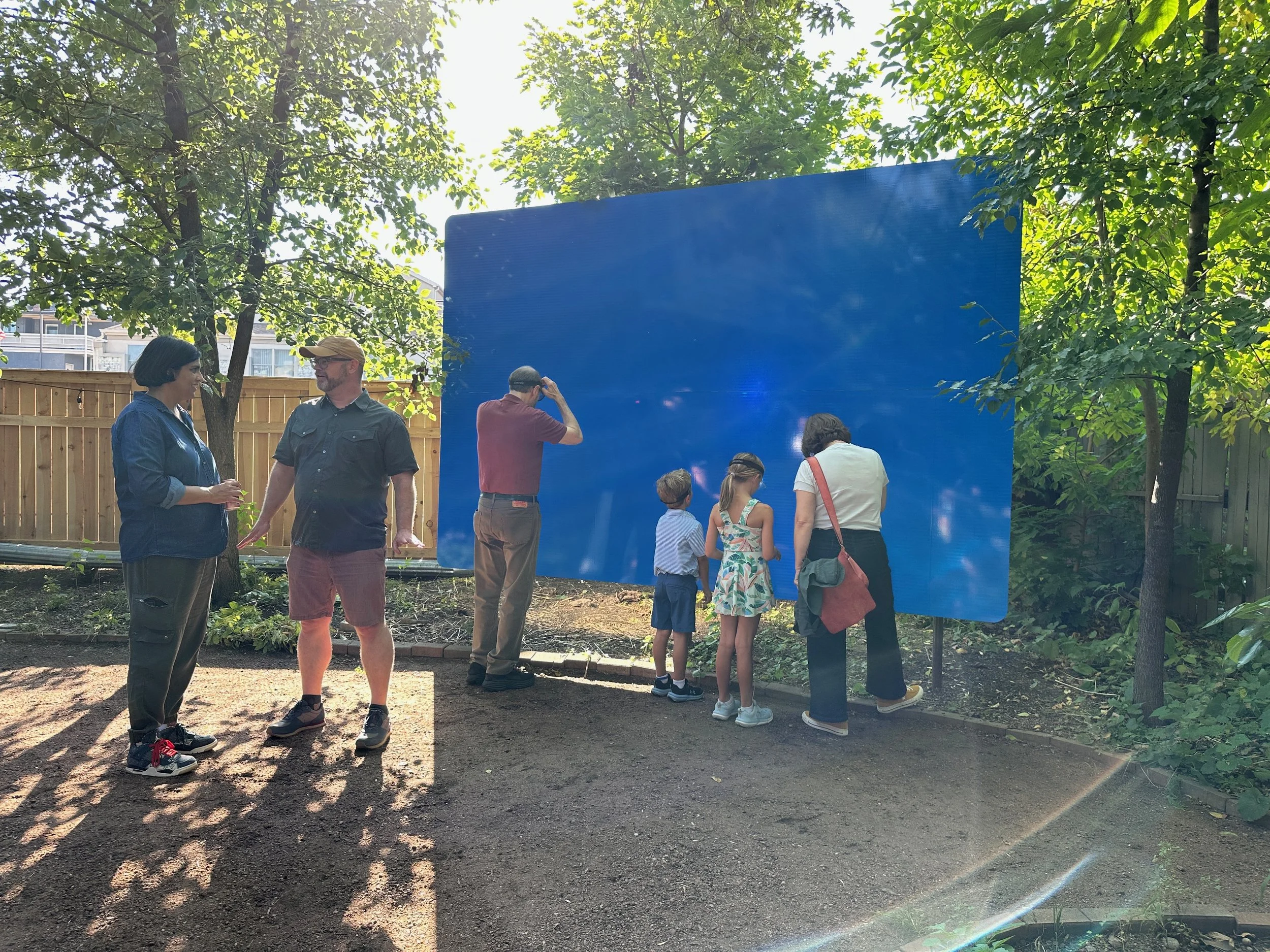


Laura Husar Garcia is a curator, artist, and creative director. Her photography has been widely exhibited, including at the Biennial of Fine Art and Documentary Photography in Prague, the Barcelona Foto Biennial, Fotofever at the Carrousel du Louvre in Paris, the Polish Museum of America, Fotofest Biennial in Houston, Photo Independent Los Angeles, the Griffin Museum of Photography in Boston, the Rangefinder Gallery, Fermilab Art Gallery, and the Schingoethe Center Museum in the Chicago area. Her work has received support and recognition from the Illinois Humanities Council, the International Julia Margaret Cameron Photography Award, and Photolucida’s Critical Mass Top 200. She is currently exhibiting at Alma Gallery in Chicago and will be showing at Pasqual’s Gallery in Santa Fe, NM in 2026.
Garcia’s photographs have been published in numerous books, including America at Home: A Close-up Look at How We Live, one of the largest collaborative photography projects in publishing history. Her work has appeared in The New York Times, National Geographic Magazine, Newsweek, Slate Magazine, Süddeutsche Zeitung, Le Monde, and more. She serves on the Exhibitions Committee at the Riverside Arts Center and is an Advisory Board Member of Fresh Lens Chicago, a free youth photography program where she has also mentored students. Laura is the Creative Director and Co-Founder of Three Story Media, which produces visual media through nonfiction storytelling.
Laura Husar Garcia viewing The Oasis, 2016-present, High-intensity prismatic film on aluminum, 8 x 12 feet, Photo: Alex Garcia

